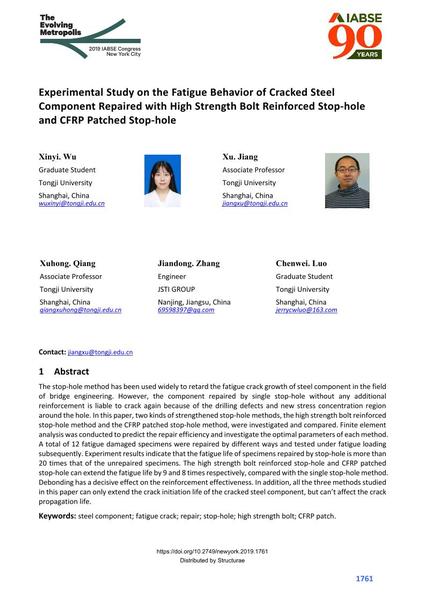Experimental Study on the Fatigue Behavior of Cracked Steel Component Repaired with High Strength Bolt Reinforced Stop-hole and CFRP Patched Stop-hole

|
|
|||||||||||
Détails bibliographiques
| Auteur(s): |
Xinyi Wu
(Tongji University)
Xu Jiang (Tongji University) Xuhong Qiang (Tongji University) Jiandong Zhang (JSTI GROUP) Chenwei Luo (Tongji University) |
||||
|---|---|---|---|---|---|
| Médium: | papier de conférence | ||||
| Langue(s): | anglais | ||||
| Conférence: | IABSE Congress: The Evolving Metropolis, New York, NY, USA, 4-6 September 2019 | ||||
| Publié dans: | The Evolving Metropolis | ||||
|
|||||
| Page(s): | 1761-1767 | ||||
| Nombre total de pages (du PDF): | 7 | ||||
| DOI: | 10.2749/newyork.2019.1761 | ||||
| Abstrait: |
The stop-hole method has been used widely to retard the fatigue crack growth of steel component in the field of bridge engineering. However, the component repaired by single stop-hole without any additional reinforcement is liable to crack again because of the drilling defects and new stress concentration region around the hole. In this paper, two kinds of strengthened stop-hole methods, the high strength bolt reinforced stop-hole method and the CFRP patched stop-hole method, were investigated and compared. Finite element analysis was conducted to predict the repair efficiency and investigate the optimal parameters of each method. A total of 12 fatigue damaged specimens were repaired by different ways and tested under fatigue loading subsequently. Experiment results indicate that the fatigue life of specimens repaired by stop-hole is more than 20 times that of the unrepaired specimens. The high strength bolt reinforced stop-hole and CFRP patched stop-hole can extend the fatigue life by 9 and 8 times respectively, compared with the single stop-hole method. Debonding has a decisive effect on the reinforcement effectiveness. In addition, all the three methods studied in this paper can only extend the crack initiation life of the cracked steel component, but can’t affect the crack propagation life. |
||||
